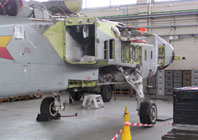With pressure on government spending, building new aircraft is often a last priority. Daniel Brown of CreaForm looks at how 3D scanning for Manufacturing, Repair and Overhaul (MRO) can assist with extending the life of aging fleets
A key challenge in aerospace is keeping old aircraft up-to-date in a context of globalisation and ever-evolving technology. However, upgrading and retrofitting aircraft, built using old methods and technology, brings a completely unique set of problems to light, such as fitting replacement parts and designing custom parts to house new technology.
The British Ministry of Defence has made a commitment to “support and upgrade existing platforms, rapidly insert new technology to meet emerging threats, (…), [and] not immediately move to design the next generation,” as outlined in the Defence Technology Strategy document. The budget in research and development for fixed-wing aircraft has followed suit: by 2014-2015, more money should be dedicated to maintenance and support than to new equipment. The challenge for the industry is now to find a new structured and cost-effective approach for inserting new capability into the aircraft to maintain the aircraft’s war-fighting effectiveness throughout its service life.

In such a structure, the design and embodiment of aircraft changes need to be fast and affordable to achieve commitments for military capability and aircraft availability, while considerably reducing cost to the taxpayer. Such an approach has been dubbed “Through-Life Capability Management”.
3D scanning has filled a gaping hole in 3D engineering, and nowhere is this more evident than when working with objects that were initially designed before 3D engineering tools were invented. Since 3D design became more widely used, there has been a coexistence of technology designed using 3D tools with technology pre-dating 3D; developing efficient approaches to retrofit and service old but still-in-use technologies while taking advantage of the recent upgrades in 3D design is a challenge that has many an engineer scratching his or her head.
This challenge brings a new set of problems to be solved. Current work methods have little in common with work methods prevailing when some of the aircraft still in use today were built; since they were mostly hand-built, the mature aircraft are more likely to have production variations, and each are becoming more and more unique with intervening maintenance changes.
Whatever systems and techniques originally used to design and manufacture the mature in-service aircraft are becoming obsolete, and these traditional techniques are labour intensive; since they have not been used in some time, the skills associated with these techniques are diminishing.
Current platforms are more labour-efficient, and so a way has to be found to bring the old technology into the new. The older aircraft were assembled according to 2D drawings, where today engineers and designers generally work with 3D models; therefore the obvious solution is to somehow create 3D models of the old, hand-built aircraft so that retrofit and upgrade can take place.
Scan model data could be integrated into computer-assisted engineering, or CAE, systems to facilitate rapid aircraft structural assessment, design, manufacture and repair. Fortunately, building 3D models of existing parts has been made possible with 3D scanning. A sufficiently accurate 3D scanner is capable of acquiring enough data to reconstruct a workable surface and enabling engineers to fit new or replacement items. The mobility of many solutions also allows the capture of existing parts, components, and assemblies on and off aircraft.
Such an approach is still relatively new, even considering the youth of 3D scanning technology. 3D scanning has made interesting leaps forward in the past few years, as the reverse engineering industry made its voice heard and applications prompted the development of devices that were the direct response to concerns and shortcomings reported by the initial users.
The nascent industry of 3D scanning kept up the development, and there are now handheld, self-positioned devices that can scan colour as well as geometry, or capture details as fine as 40µm in width. With that level of precision, replacement parts, or even the tools with which to install them, are designed at a fraction of the cost and time that would be required with more traditional methods of analysis and measurement.
The devices have also grown smaller, more compact and portable, so that deployability is no longer an issue. Self-positioning also means that 3D scanning can now take place without having to use external positioning devices, so that preparation for a scan takes very little time.
3D scanning technology is also sufficiently versatile to justify the investment, however comparatively small, that the purchase of such devices entail; 3D scanners can be and have been used to reverse engineer prototype aircraft, install modifications to recently introduced aircraft types, and enable fast-response repairs.
Daniel Brown is the Handyscan 3D Product Manager at Creaform. creaform3d.com
3D scanning for Manufacturing, Repair and Overhaul can assist with extending the life of aging fleets
No






